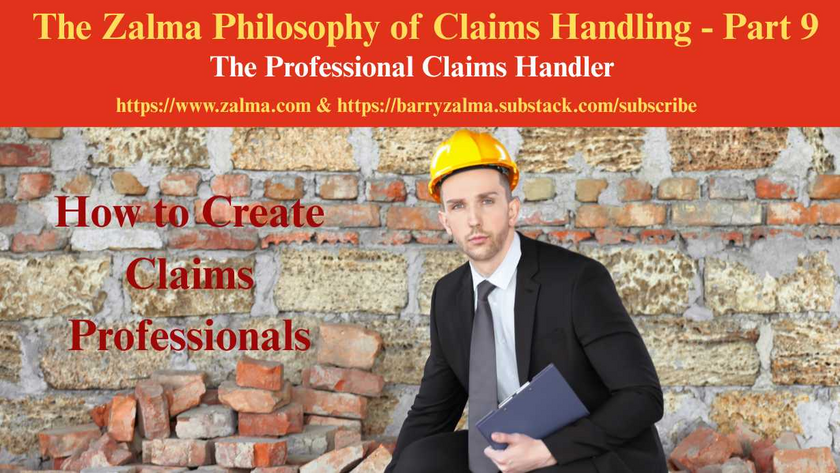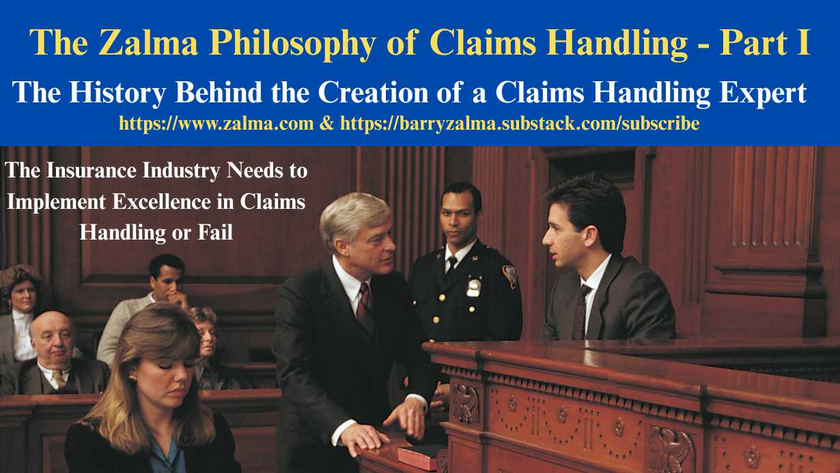
To Obtain Coverage Insured Must Pay a Premium
Barry Zalma
Jan 18, 2024
Read the full article at https://lnkd.in/gAPYAgC4, see the full video at https://lnkd.in/gUrbi2MU and at https://lnkd.in/gvm5zZek and at https://zalma.com/blog plus more than 4700 posts.
Erie Insurance Exchange (Erie Insurance) claims that the trial court erred in granting partial summary judgment in favor of Icon, d/b/a Allure on the Lake (Icon), on Icon’s complaint for breach of contract. Erie Insurance contends that the trial court improperly determined as a matter of law that the commercial insurance policy (the Policy) it issued to Icon was ambiguous and entitled Icon to additional income protection coverage after a fire had destroyed Icon’s building.
In Erie Insurance Exchange v. Icon, Inc., d/b/a Allure on the Lake, et al., No. 23A-PL-664, Court of Appeals of Indiana (January 12, 2024) the Court of Appeals interpreted the entire policy.
FACTS
On June 3, 2019, a fire in Chesterton, Indiana destroyed a banquet hall (the Hall) that Icon owned. At the time of the fire, the Hall was insured by Erie Insurance. The Policy stated that “in return for your timely premium payment, your compliance with all of the provisions of this policy . . . [Erie Insurance agrees] to provide the coverages you have purchased.” [emphasis added]
The Declarations page specifically directed the insured to refer to the Supplemental Declarations to find additional information about included coverages under the Policy. Income protection coverage-as identified in “Coverage 3” of the Declarations-is defined as loss of “income” and/or “rental income” you sustain due to partial or total “interruption of business” resulting directly from “loss” or damage to property on the premises described in the “Declarations” from a peril insured against. “Loss” or damage also includes property in the open, or in a vehicle, on the premises described in the “Declarations” or within 1,500 feet thereof.
The Supplemental Declarations specifically indicate what “amount of insurance” the Policy provides for by displaying a dollar amount under the “amount of insurance” column.
The Policy further provided that when additional income coverage is not purchased by the insured, a minimal, i.e., “standard” protection coverage is provided as part of the basic package.
CLAIM PAYMENTS
After the Hall was destroyed, Icon submitted a timely claim to Erie Insurance under the Policy. Although Erie Insurance paid both the property damage and building contents portion of Icon’s claim, it maintained that the maximum income protection afforded under the Policy was $25,000 and not $1 million because Icon did not pay a premium for additional income protection coverage.
REFUSAL TO PAY INCOME LOSSES
When Erie Insurance refused to pay for those additional losses, Icon filed an amended complaint against Erie Insurance on March 10, 2020, for breach of contract and bad faith. Thereafter, Erie Insurance filed a motion for partial summary judgment, claiming that it was entitled to judgment as a matter of law because Icon did not pay a premium for additional income protection and, therefore, the $1 million maximum coverage was not available to Icon for its income losses.
The trial court granted Icon’s cross-motion for partial summary judgment, concluding that the Policy was ambiguous as to the available amount of income protection coverage to which Icon was entitled.
DISCUSSION AND DECISION
Insurance policies are contracts subject to the same rules of judicial construction as other contracts. Insurance policies must be read as a whole. That is, specific words and phrases cannot be construed exclusive of other policy provisions. Furthermore, the language of an insurance policy should be construed so as not to render any words, phrases or terms ineffective or meaningless.
In this case, the first page of the Declarations in the Policy denotes the coverages for which Icon paid a premium. The Policy’s plain language was clear that the “Each Occurrence Limit” is specifically limited to include the total amount of insurance that will be paid for bodily injury or property damage liability and for medical expenses under the liability portion of the Policy. Hence, the unambiguous language of the Policy demonstrates that the “Each Occurrence Limit” on page l of the Declarations, which Icon relies upon, is a limit for general liability coverage, not a limit for property coverage. As a result, the $1 million “Each Occurrence Limit” shown there is irrelevant to the amount of income protection coverage afforded under the Policy.
The lack of a dollar amount for Coverage 3 is a clear and unambiguous statement that additional income protection coverage was not included for the subject property.
The Declarations show that Icon paid no premium for Coverage 3-income protection-and, in accordance with the plain language of the Policy, Erie Insurance did not provide such coverage to Icon. Thus, Icon is limited to income protection coverage up to $25,000 in accordance with the standard protection section of the Policy.
The trial court’s conclusion was reversed and the trial court was instructed to enter partial summary judgment for Erie Insurance and to conduct further proceedings consistent with this opinion.
ZALMA OPINION
Insurance contracts must be read before accepting the offer from an insurer to insure. In this case the insured, Icon, either failed to read the coverages provided or decided to not purchase income coverages. The Court of Appeals found that since Icon did not pay a premium for the income coverage it had no coverage. Regardless of why it did not pay the premium by not doing so Icon recovered the minimal coverage for Income but not the coverages they wanted after a real loss.
(c) 2024 Barry Zalma & ClaimSchool, Inc.
Please tell your friends and colleagues about this blog and the videos and let them subscribe to the blog and the videos.
Subscribe to my substack at https://barryzalma.substack.com/publish/post/107007808
Go to Newsbreak.com https://www.newsbreak.com/@c/1653419?s=01
Go to X @bzalma; Go to the podcast Zalma On Insurance at https://podcasters.spotify.com/pod/show/barry-zalma/support; Go to Barry Zalma videos at Rumble.com at https://rumble.com/c/c-262921; Go to Barry Zalma on YouTube- https://www.youtube.com/channel/UCysiZklEtxZsSF9DfC0Expg; Go to the Insurance Claims Library – http://zalma.com/blog/insurance-claims-library.
Please tell your friends and colleagues about this blog and the videos and let them subscribe to the blog and the videos.
Subscribe to my substack at https://lnkd.in/gcZKhG6g
Go to Newsbreak.com https://lnkd.in/g8azKc34 ; Go to X @bzalma; Go to the podcast Zalma On Insurance at https://lnkd.in/gSwXaUhz; Go to Barry Zalma videos at Rumble.com at https://lnkd.in/gV9QJYH; Go to Barry Zalma on YouTube- https://lnkd.in/g2hGv88;
Go to the Insurance Claims Library – https://lnkd.in/gwEYkxD.
Insurer’s Exclusion for Claims of Assault & Battery is Effective
Post 5250
Read the full article at https://lnkd.in/gBzt2vw9, see the video at https://lnkd.in/gEBBE-e6 and at https://lnkd.in/gk7EcVn9, and at https://zalma.com/blog plus more than 5250 posts.
Bar Fight With Security is an Excluded Assault & Battery
In The Cincinnati Specialty Underwriters Insurance Company v. Mainline Private Security, LLC, et al., Civil Action No. 24-3871, United States District Court, E.D. Pennsylvania (December 16, 2025) two violent attacks occurred in Philadelphia involving young men, Eric Pope (who died) and Rishabh Abhyankar (who suffered catastrophic injuries). Both incidents involved security guards provided by Mainline Private Security, LLC (“Mainline”) at local bars. The estates of the victims sued the attackers, the bars, and Mainline for negligence and assault/battery. The insurer exhausted a special limit and then denied defense or indemnity to Mainline Private Security.
INSURANCE COVERAGE
Mainline had purchased a commercial ...
Marine Insurer May Dispose of Vessel to Avoid Waste
Post 5249
Read the full article at https://lnkd.in/gfn_UHdp, see the video at https://lnkd.in/gDWVccnr and at https://lnkd.in/gv9nsBqk, and https://zalma.com/blog plus more than 5200 posts.
In Western World Insurance Company v. The Estate Of Shawn Arsenault, No. 25-cv-13413-PGL, United States District Court, D. Massachusetts (December 17, 2025) the USDC was asked to resolve a marine insurance dispute after the sinking of the F/V Seahorse, a commercial fishing vessel, off Cape Cod on June 8, 2025. The vessel’s owner and operator, Shawn Arsenault, died in the incident.
Western World Insurance Company issued a hull insurance policy for the vessel. With no personal representative yet appointed for the estate, the insurer cannot determine the proper payee for the insurance proceeds.
The insurer paid for the vessel’s recovery and removal, and the vessel is now with a salvage company, incurring substantial storage fees. The insurer determined the loss is covered under the ...
Marine Insurer May Dispose of Vessel to Avoid Waste
Post 5249
Read the full article at https://lnkd.in/gfn_UHdp, see the video at https://lnkd.in/gDWVccnr and at https://lnkd.in/gv9nsBqk, and https://zalma.com/blog plus more than 5200 posts.
In Western World Insurance Company v. The Estate Of Shawn Arsenault, No. 25-cv-13413-PGL, United States District Court, D. Massachusetts (December 17, 2025) the USDC was asked to resolve a marine insurance dispute after the sinking of the F/V Seahorse, a commercial fishing vessel, off Cape Cod on June 8, 2025. The vessel’s owner and operator, Shawn Arsenault, died in the incident.
Western World Insurance Company issued a hull insurance policy for the vessel. With no personal representative yet appointed for the estate, the insurer cannot determine the proper payee for the insurance proceeds.
The insurer paid for the vessel’s recovery and removal, and the vessel is now with a salvage company, incurring substantial storage fees. The insurer determined the loss is covered under the ...
Zalma’s Insurance Fraud Letter
Read the full article at https://lnkd.in/dG829BF6; see the video at https://lnkd.in/dyCggZMZ and at https://lnkd.in/d6a9QdDd.
ZIFL Volume 29, Issue 24
Subscribe to the e-mail Version of ZIFL, it’s Free! https://visitor.r20.constantcontact.com/manage/optin?v=001Gb86hroKqEYVdo-PWnMUkcitKvwMc3HNWiyrn6jw8ERzpnmgU_oNjTrm1U1YGZ7_ay4AZ7_mCLQBKsXokYWFyD_Xo_zMFYUMovVTCgTAs7liC1eR4LsDBrk2zBNDMBPp7Bq0VeAA-SNvk6xgrgl8dNR0BjCMTm_gE7bAycDEHwRXFAoyVjSABkXPPaG2Jb3SEvkeZXRXPDs%3D
Zalma’s Insurance Fraud Letter (ZIFL) continues its 29th year of publication dedicated to those involved in reducing the effect of insurance fraud. ZIFL is published 24 times a year by ClaimSchool and is written by Barry Zalma. It is provided FREE to anyone who visits the site at http://zalma.com/zalmas-insurance-fraud-letter-2/
Zalma’s Insurance Fraud Letter
Merry Christmas & Happy Hannukah
Read the following Articles from the December 15, 2025 issue:
Read the full 19 page issue of ZIFL at ...
The Professional Claims Handler
Post 5219
Posted on October 31, 2025 by Barry Zalma
An Insurance claims professionals should be a person who:
Can read and understand the insurance policies issued by the insurer.
Understands the promises made by the policy.
Understand their obligation, as an insurer’s claims staff, to fulfill the promises made.
Are competent investigators.
Have empathy and recognize the difference between empathy and sympathy.
Understand medicine relating to traumatic injuries and are sufficiently versed in tort law to deal with lawyers as equals.
Understand how to repair damage to real and personal property and the value of the repairs or the property.
Understand how to negotiate a fair and reasonable settlement with the insured that is fair and reasonable to both the insured and the insurer.
How to Create Claims Professionals
To avoid fraudulent claims, claims of breach of contract, bad faith, punitive damages, unresolved losses, and to make a profit, insurers ...

The History Behind the Creation of a Claims Handling Expert
The Insurance Industry Needs to Implement Excellence in Claims Handling or Fail
Post 5210
This is a change from my normal blog postings. It is my attempt. in more than one post, to explain the need for professional claims representatives who comply with the basic custom and practice of the insurance industry. This statement of my philosophy on claims handling starts with my history as a claims adjuster, insurance defense and coverage lawyer and insurance claims handling expert.
My Training to be an Insurance Claims Adjuster
When I was discharged from the US Army in 1967 I was hired as an insurance adjuster trainee by a professional and well respected insurance company. The insurer took a chance on me because I had been an Army Intelligence Investigator for my three years in the military and could use that training and experience to be a basis to become a professional insurance adjuster.
I was initially sat at a desk reading a text-book on insurance ...














